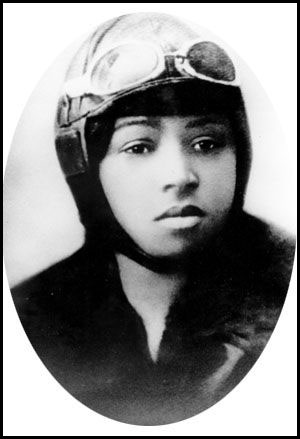
Bessie Coleman
Bessie Coleman, the daughter of a poor, southern, African American family, became one of the most famous women and African Americans in aviation history. "Brave Bessie" or "Queen Bess," as she became known, faced the double difficulties of racial and gender discrimination in early 20th-century America but overcame such challenges to become the first African American woman to earn a pilot's license. Coleman became a role model for women and African Americans. Her very presence in the air threatened prevailing contemporary stereotypes. She also fought segregation when she could by using her influence as a celebrity to effect change, no matter how small.
Coleman was born on January 26, 1892, in Atlanta, Texas, where she grew up picking cotton and doing laundry for customers with her mother.
The Coleman family, faced many disadvantages and difficulties. Bessie's family dealt with segregation, disenfranchisement, and racial violence. Bessie was a highly motivated individual. Despite working long hours, she still found time to educate herself by borrowing books from a traveling library.
By 1915, Bessie moved to Chicago. There, she began living with two of her brothers. She attended beauty school and then started working as a manicurist in a local barbershop.
Bessie first considered becoming a pilot after reading about aviation and watching newsreels about flight. But the real impetus behind her decision to become an aviator was her brother John's incessant teasing. John had served overseas during World War I and returned home talking about, according to historian Doris Rich, "the superiority of French women over those of Chicago's South Side." He even told Bessie that French women flew airplanes and declared that flying was something Bessie would never be able to do. John's jostling was the final push that Bessie needed to start pursuing her pilot's license. She immediately began applying to flight schools throughout the country, but because she was both female and an African American, no U.S. flight school would take her.
Soon after being turned down by American flight schools, Coleman met Robert Abbott, publisher of the well-known African American newspaper, the Chicago Defender. He recommended that Coleman save some money and move to France, which he believed was the world's most racially progressive nation, and obtain her pilot's license there. Coleman quickly heeded Abbott's advice. Bessie took her savings and sailed for France. She also received some additional funds from Abbott and one of his friends.
Coleman attended the well-known Caudron Brothers' School of Aviation in Le Crotoy, France. On June 15, 1921, Coleman obtained her pilot's license from Federation Aeronautique Internationale after only seven months. She was the first black woman in the world to earn an aviator's license. After some additional training in Paris, Coleman returned to the United States in September 1921.
Coleman's main goals when she returned to America were to make a living flying and to establish the first African American flight school. Because of her color and gender, however, she was somewhat limited in her first goal. Barnstorming seemed to be the only way for her to make money, but to become an aerial daredevil, Coleman needed more training. Once again, Bessie applied to American flight schools, and once again they rejected her. So in February 1922, she returned to Europe. After learning most of the standard barnstorming tricks, Coleman returned to the United States.
Bessie flew in her first air show on September 3, 1922, at Glenn Curtiss Field in Garden City, New York. Bessie became a celebrity. She subsequently began touring the country giving exhibitions, flight lessons, and lectures. During her travels, she strongly encouraged African Americans and women to learn to fly.
Even though Coleman realized that she had to work within the general confines of southern segregation, she did try to use her fame to challenge racial barriers. Bessie returned to her old hometown of Waxahachie to give an exhibition. As in Houston, both whites and African Americans wanted to attend the event and plans called for segregated facilities. Officials even wanted whites and African Americans to enter the venue through separate "white" and "Negro" admission gates, but Coleman refused to perform under such conditions. She demanded only one admission gate. Coleman got her way and Texans of both races entered the air field through the same gate.
Coleman's aviation career ended tragically in 1926. On April 30, she died while preparing for a show in Jacksonville, Florida. Coleman was riding in the passenger seat of her "Jenny" airplane while her mechanic William Wills was piloting the aircraft. Bessie was not wearing her seat belt at the time so that she could lean over the edge of the cockpit and scout potential parachute landing. But while Bessie was scouting from the back seat, the plane suddenly dropped into a steep nose dive and then flipped over and catapulted her to her death.
Despite her relatively short career, Bessie Coleman strongly challenged early 20th century stereotypes about white supremacy and the inabilities of women. By becoming the first licensed African American female pilot, and performing throughout the country, Coleman proved that people did not have to be shackled by their gender or the color of their skin to succeed and realize their dreams.
--David H. Onkst